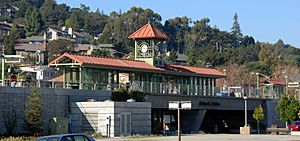Belmont, California facts for kids
Quick facts for kids
Belmont, California
|
||
|---|---|---|
| City of Belmont | ||
 |
||
|
||

Location of Belmont in San Mateo County, California
|
||
| Country | United States | |
| State | California | |
| County | San Mateo | |
| Incorporated | October 29, 1926 | |
| Area | ||
| • Total | 4.64 sq mi (12.01 km2) | |
| • Land | 4.63 sq mi (11.99 km2) | |
| • Water | 0.01 sq mi (0.02 km2) 0.19% | |
| Elevation | 43 ft (13 m) | |
| Population
(2020)
|
||
| • Total | 28,335 | |
| • Density | 6,119.87/sq mi (2,363.11/km2) | |
| Time zone | UTC-8 (Pacific) | |
| • Summer (DST) | UTC-7 (PDT) | |
| ZIP code |
94002
|
|
| Area code | 650 | |
| FIPS code | 06-05108 | |
| GNIS feature IDs | 1658029, 2409826 | |
Belmont is a city in San Mateo County, California. It is located in the San Francisco Bay Area, on the San Francisco Peninsula. Belmont is about halfway between the big cities of San Francisco and San Jose.
The city was officially started in 1926. Its name comes from the Italian words bel monte, which mean "beautiful mountain." This name was chosen because of a pretty, rounded hill nearby. In 2020, about 28,335 people lived in Belmont.
Belmont is known for Ralston Hall, a historic building on the campus of Notre Dame de Namur University. It was built by a famous banker named William Chapman Ralston. You can also find "Waterdog Lake" in Belmont's hills. A special building from the 1915 Panama–Pacific International Exposition is also located here.
The city shares borders with San Mateo to the north and San Carlos to the south. To the west is Half Moon Bay, and to the east is Redwood Shores. Belmont has a strict rule against smoking in many public places and apartments.
Contents
Belmont's History and Name

The land where Belmont now stands was once part of a large area called Rancho de las Pulgas. One of Belmont's main roads, the Alameda de las Pulgas, is named after this historic ranch.
The name Belmont is thought to come from the Italian phrase bel monte. This means "beautiful mountain." The town was named for a "symmetrically rounded eminence" or hill nearby.
Belmont's Location and Size
Belmont is located at 37°31′5″N 122°17′30″W / 37.51806°N 122.29167°W.
The city covers about 4.63 square miles (11.99 square kilometers) of land. It also has a very small amount of water, about 0.01 square miles (0.02 square kilometers).
People Living in Belmont
Belmont has grown quite a bit over the years. In 1880, only 202 people lived here. By 2020, the population had grown to 28,335 people.
The city is a diverse place, with people from many different backgrounds living together. In 2020, about half of the residents were White, and nearly 30% were Asian. Many other races and people of mixed races also call Belmont home. About 12% of the residents were of Hispanic or Latino background.
Belmont is a good place for families. In 2010, about 30% of households had children under 18. The average household had about 2.39 people.
In 2009, Forbes magazine even ranked Belmont as one of "America's Top 25 Towns to Live Well."
Schools and Learning in Belmont
Belmont is known for its excellent public schools. Most of the public schools are managed by the Belmont – Redwood Shores School District (BRSSD). The public high school, Carlmont High School, is part of a different district.
Public Schools
Elementary Schools
- Central Elementary School
- Cipriani Elementary School
- Fox Elementary School
- Nesbit Elementary School
Middle Schools
- Ralston Middle School
- Nesbit School (which goes from kindergarten to 8th grade)
High School
- Carlmont High School
Private Schools
- Immaculate Heart of Mary School (preschool through 8th grade)
- Notre Dame High School
- Charles Armstrong School (a special school for students with learning differences like dyslexia)
Colleges and Universities
- Notre Dame de Namur University
Getting Around Belmont
Belmont has good public transportation options.
SamTrans provides bus services throughout Belmont and San Mateo County. For longer trips, Caltrain offers commuter train service. The train runs along the San Francisco Peninsula, connecting Belmont to cities like San Francisco and San Jose. Belmont has its own train stop, Belmont station.
Local Businesses and Jobs
Belmont has a variety of businesses that provide jobs for its residents.
According to a 2021 report, some of the top employers in the city include:
| # | Employer | # of Employees |
|---|---|---|
| 1 | RingCentral, Inc. | 693 |
| 2 | Autobahn Motors | 129 |
| 3 | Safeway Store #1138 | 112 |
| 4 | Volkswagen Group of America | 109 |
| 5 | Nikon Precision, Inc. | 95 |
| 6 | Silverado Senior Living | 95 |
| 7 | Lunardi's Market | 82 |
| 8 | James Electronics Ltd. | 62 |
| 9 | Woodmont Real Estate Services | 57 |
| 10 | Merry Moppet Preschool, Inc. | 55 |
Friends Around the World
Belmont has "sister cities," which are cities in other places that share a special connection. These connections help promote cultural understanding and friendship.
Belmont's sister cities are:
Images for kids
See also
 In Spanish: Belmont (California) para niños
In Spanish: Belmont (California) para niños







